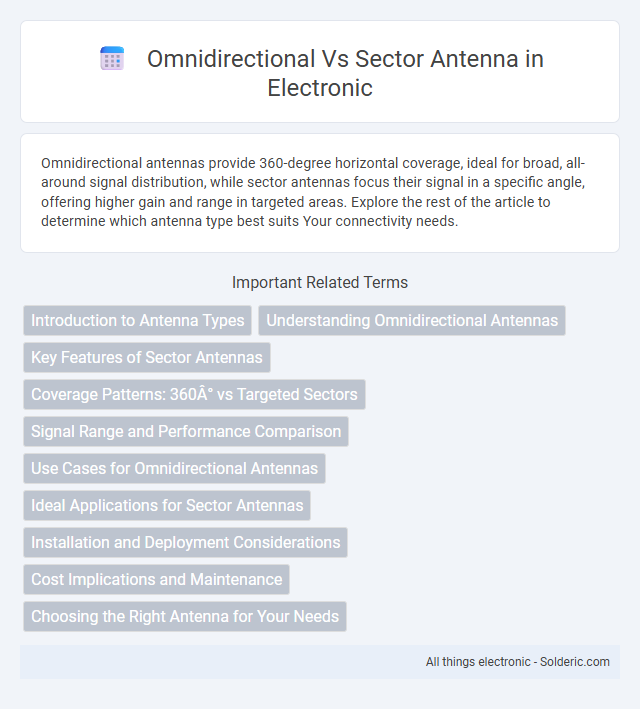Omnidirectional antennas provide 360-degree horizontal coverage, ideal for broad, all-around signal distribution, while sector antennas focus their signal in a specific angle, offering higher gain and range in targeted areas. Explore the rest of the article to determine which antenna type best suits Your connectivity needs.
Comparison Table
| Feature | Omnidirectional Antenna | Sector Antenna |
|---|---|---|
| Coverage Pattern | 360-degree horizontal coverage | 60deg to 120deg horizontal coverage |
| Use Case | Wide area coverage for densely populated or small areas | Focused coverage for targeted directional zones |
| Gain | Typically 2-8 dBi | Typically 8-16 dBi |
| Signal Directivity | Non-directional, radiates equally in all directions | Directional, radiates within a specific sector |
| Deployment | Simple setup, ideal for mobile or indoor use | Requires alignment, ideal for outdoor base stations |
| Interference | Higher potential for interference due to broad coverage | Lower interference with focused beam |
| Typical Applications | Wi-Fi routers, cellular repeaters, urban hotspots | Cell towers, point-to-multipoint wireless networks |
Introduction to Antenna Types
Omnidirectional antennas provide 360-degree signal coverage, making them ideal for broad area communication, such as in Wi-Fi routers or cellular base stations. Sector antennas focus their signal in a specific direction, offering higher gain and better range within a defined sector, which is beneficial for targeted wireless network deployments. Understanding the differences between these antenna types helps you select the right solution based on coverage needs and signal strength requirements.
Understanding Omnidirectional Antennas
Omnidirectional antennas provide 360-degree horizontal coverage, making them ideal for environments where signals need to be transmitted or received in all directions equally. These antennas are commonly used in wireless networks, such as Wi-Fi and cellular systems, to ensure consistent connectivity across open spaces. Your wireless setup benefits from omnidirectional antennas when uniform signal distribution is essential, unlike sector antennas that focus signals in specific directions for targeted coverage.
Key Features of Sector Antennas
Sector antennas provide focused coverage with a specific horizontal beamwidth, typically ranging from 60deg to 120deg, enabling targeted signal distribution in cellular and Wi-Fi networks. Their high gain, often between 8 to 15 dBi, enhances signal strength and improves network capacity compared to omnidirectional antennas. Sector antennas facilitate interference reduction and efficient frequency reuse, making them ideal for dense urban or clustered deployment scenarios.
Coverage Patterns: 360° vs Targeted Sectors
Omnidirectional antennas provide a 360deg coverage pattern, allowing signals to radiate evenly in all horizontal directions, ideal for broad area coverage and environments with devices scattered around. Sector antennas focus their signal within specific angular sectors, typically between 60deg and 120deg, delivering higher gain and improved signal strength in targeted zones. This makes sector antennas perfect for dividing large areas into manageable segments, enhancing network capacity and reducing interference in densely populated wireless deployments.
Signal Range and Performance Comparison
Omnidirectional antennas provide a 360-degree signal coverage ideal for broad-area connectivity but typically offer shorter effective range due to signal dispersion. Sector antennas focus their signal within a specific 60 to 120-degree area, resulting in stronger performance and longer range within that sector by concentrating energy. Choosing the right antenna depends on your need for comprehensive coverage versus targeted high-performance connections.
Use Cases for Omnidirectional Antennas
Omnidirectional antennas are ideal for providing 360-degree wireless coverage in environments where users or devices are spread out evenly, such as in open office spaces, public Wi-Fi hotspots, or large outdoor areas. These antennas efficiently transmit and receive signals in all directions, making them suitable for supporting mobile users and devices moving freely within the coverage zone. Your network benefits from consistent connectivity and simplified deployment when using omnidirectional antennas in applications requiring broad, uniform signal distribution.
Ideal Applications for Sector Antennas
Sector antennas excel in providing targeted wireless coverage across specific areas, making them ideal for outdoor networks in stadiums, campuses, and urban hotspots. These antennas deliver focused signal strength over a fixed angular range, enhancing capacity and reducing interference compared to omnidirectional antennas. Your network benefits from improved performance and scalability when deploying sector antennas in environments requiring high-density, directional coverage.
Installation and Deployment Considerations
Omnidirectional antennas offer simplified installation with 360-degree coverage, ideal for environments requiring broad signal distribution and minimal alignment efforts. Sector antennas demand precise orientation and mounting on structures like towers or poles to optimize their focused coverage areas and maximize signal strength. Deployment decisions hinge on site geography, desired coverage patterns, and infrastructure compatibility for seamless network performance.
Cost Implications and Maintenance
Omnidirectional antennas generally have lower initial costs and simpler installation compared to sector antennas, which require more complex alignment and multiple units for coverage. Maintenance for omnidirectional antennas is typically less intensive due to their single, robust design, whereas sector antennas need more frequent inspections and adjustments to ensure each sector functions optimally. Cost implications also extend to network scalability, with sector antennas offering better long-term cost efficiency in high-density areas despite higher upfront expenses.
Choosing the Right Antenna for Your Needs
Selecting the right antenna depends on your coverage requirements and environment; omnidirectional antennas provide 360-degree signal distribution ideal for broad coverage in open or circular spaces, while sector antennas focus signals into narrower beams, delivering higher gain and better performance for targeted areas. Your choice should weigh factors like range, interference, and user density to optimize network efficiency. Understanding these parameters ensures your wireless system meets precise connectivity demands.
omnidirectional vs sector antenna Infographic

 solderic.com
solderic.com